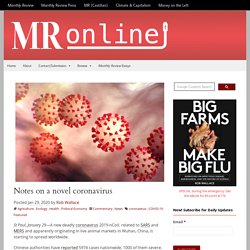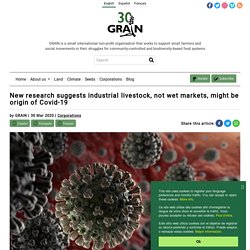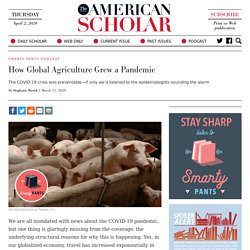

The Next Pandemic: Last Week Tonight with John Oliver (HBO) Denmark to Kill Millions of Minks Due to COVID-19 Outbreak. How Coronavirus Broke America. New Rule: America's Wet Markets. Notes on a novel coronavirus. St Paul, January 29—A new deadly coronavirus 2019-nCoV, related to SARS and MERS and apparently originating in live animal markets in Wuhan, China, is starting to spread worldwide.

Chinese authorities have reported 5974 cases nationwide, 1000 of them severe. With infections in nearly every province, authorities warned 2019-nCoV appears to be spreading fast out of its epicenter. The characterization appears supported by initial modeling. The virus’s basic reproduction number, a measure of the number of new cases per infection given no cap on available susceptibles, is clocking in at a healthy 3.11. That means in the face of such momentum, a control campaign must stop up to 75% of new infections to reverse the outbreak. Full-genome sequences of the virus meanwhile show few differences between the samples isolated across China. The coronavirus is starting to open up theaters overseas. Pandemic skeptics aren’t so sure of such a scenario.
Outbreaks are dynamic. Clarity can sour a soul. Is factory farming to blame for coronavirus? Where did the virus causing the current pandemic come from?

How did it get to a food market in Wuhan, China, from where it is thought to have spilled over into humans? The answers to these questions are gradually being pieced together, and the story they tell makes for uncomfortable reading. Let’s start at the beginning. As of 17 March, we know that the Sars-CoV-2 virus (a member of the coronavirus family that causes the respiratory illness Covid-19) is the product of natural evolution. A study of its genetic sequence, conducted by infectious disease expert Kristian G Andersen of the Scripps Research Institute in La Jolla, California, and colleagues, rules out the possibility that it could have been manufactured in a lab or otherwise engineered.
The next step is a little less certain, but it seems likely that the original animal reservoir for the virus was bats. “Our study does not directly shed light on the geographical origin of the virus,” says Andersen. New research suggests industrial livestock, not wet markets, might be origin of Covid-19. Image credit: World Health Organization/Getty Let’s be clear: there is no solid evidence that the origin of the SARS-CoV-2 virus, which is the cause of the current Covid-19 disease pandemic, is an open seafood market in Wuhan that also trades in domestic and wild animals.

All that we know is that several early cases of people diagnosed with Covid-19 either worked at this market or shopped there in the days preceding their diagnosis. Many media outlets and pundits have seized on this information to claim that Chinese wet markets and the live trade in domestic and wild animals are to blame for the emergence of the disease1. And some are even calling for a ban on wet markets— which are vital to the livelihoods and food security of millions of small farmers, traders and consumers2.
There is a growing body of evidence that points to a different origin story for Covid-19. So which animals fit this criteria? 8. 12. How Global Agriculture Grew a Pandemic - <a href=' Bastek</a> Kim Bartlett/Animal People, Inc.

We are all inundated with news about the COVID-19 pandemic, but one thing is glaringly missing from the coverage: the underlying structural reasons for why this is happening. Yes, in our globalized economy, travel has increased exponentially in the past 20 years, not just for pleasure, but also for profit. Still, that alone does not explain why we’ve had a litany of infectious disease outbreaks over the same period, each one coming hot on the heels of the last and doing nothing to alter our public health response. What does? Evolutionary biologist Rob Wallace, of the Institute for Global Studies at the University of Minnesota, has some answers. Go beyond the episode: Tune in every week to catch interviews with the liveliest voices from literature, the arts, sciences, history, and public affairs; reports on cutting-edge works in progress; long-form narratives; and compelling excerpts from new books.
Download the audio here (right click to “save link as …”)